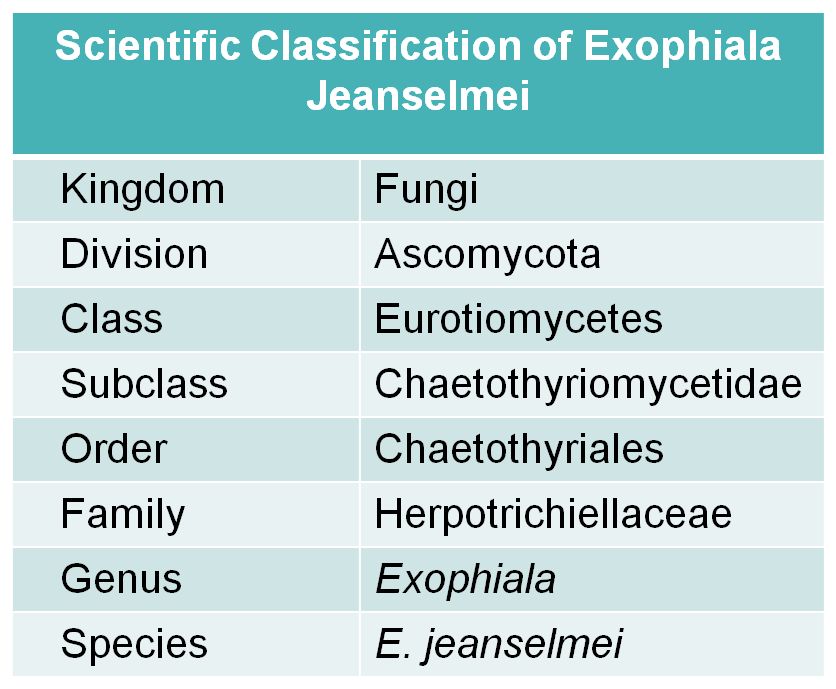Exophiala jeanselmei
Exophiala jeanselmei (E. jeanselmei) infection can cause human chromoblastomycosis, a chronic, cutaneous, and subcutaneous disease. Studying the pathogenic mechanism of E. jeanselmei is beneficial for the exploration and therapeutic applications of chromoblastomycosis. With advanced technologies and numerous skilled professionals, Creative Biolabs has accumulated considerable experience in the fields of antifungal drug discovery. Currently, we can provide quality products and valuable services in the researches of Exophiala jeanselmei, nosogenesis and therapies of chromoblastomycosis.
Background of Exophiala Jeanselmei
E. jeanselmei is a saprotrophic fungus, belonging to the genus of Exophiala, family Herpotrichiellaceae. In 1928, it was first isolated from a patient with black mycetoma on the foot. Now, it has been recognized as one opportunistic pathogen causing cutaneous/subcutaneous invasive infections, especially in immunocompromised and debilitated individuals. There are four varieties of E. jeanselmei that have been discovered, namely E. jeanselmei var. heteromorpha, E. jeanselmei var. lecanii-corner, E. jeanselmei var. jeanselmei, and E. jeanselmei var. castellanii. The widespread Exophiala genus contains about 28 species and most of them are common environmental fungi which are often associated with decaying wood and soil enriched with organic wastes. Several species are well documented human pathogens, including E. jeanselmei, E. dermatitidis, and E. spinier.
 Fig.1 Scientific classification of E. jeanselmei.
Fig.1 Scientific classification of E. jeanselmei.
Distribution of Exophiala Jeanselmei
E. jeanselmei is found worldwide, but the predominant distribution is in tropical and sub-tropical regions, especially in Asia. Decaying wood, plants, water, and soil enriched with organic wastes are the most common habitats. It is notable that the Exophiala species can survive in the hot, humid, and oligotrophic environments such as dishwashers, steam bath facilities, and bathrooms, which are also alternative habitats for human pathogenic species. The optimal growth temperature of E. jeanselmei isolated from soil is 30 °C, while strains isolated from humans can grow at higher temperatures such as 37 °C of the human body.
Morphological Features of Exophiala Jeanselmei
E. jeanselmei colonies grow slowly and present green-black in color. The cultures are diverse from mycelial to yeast-like growth forms and the yeast-like typically predominates. It is characteristic that black aerial mycelium develops on the colony surface which consists of hyphae with swellings at regular intervals. The mature conidiogenous cells are rocket-shaped (2.6-5.9 µm × 1.2-2.5 µm), slightly darker than the supporting hyphae, with regular tapering annellated zones. Conidia are often formed in clusters at the tip of annellidic conidiogenous cells.
Pathogenesis of Exophiala Jeanselmei
Acting as an opportunistic pathogen, E. jeanselmei may cause mycetoma, chromoblastomycosis, phaeohyphomycosis, and occasional eumycetoma. The common clinical manifestation of E. jeanselmei is mycetoma, a chronic granulomatous inflammatory disease that presents with black or brown macular lesions which enlarge by peripheral extension. Chromoblastomycosis is a chronic cutaneous and subcutaneous disease characterized by verrucose skin lesions eventually leading to emerging cauliflower-like eruptions, which are caused by several melanized fungi. The presence of sclerotic bodies in infected skin are hallmarks of this disease. Phaeohyphomycosis is a heterogeneous group of mycotic infections, mainly caused by dematiaceous fungi which can present different morphologic characteristics in tissues, include hyphae, yeast-like cells, or a combination of both. Eumycetoma is a chronic granulomatous disease in the form of black grains.
Promotion of antifungal drug discovery is crucial to preventing life-threatening disease. As a well-recognized research partner, Creative Biolabs can help you address your research requirements in the study of E. jeanselmei. With our integrated multiple cutting-edge technologies, we can offer valuable suggestions and reliable services to meet your particular needs in therapeutic applications of fungal infection. Please feel free to contact us for more information and technical support.
For Research Use Only.
